by Matt Corrion
The team of landscape architects at Outdoor Design Group, Inc. are thrilled to be partnering with Bud Surles Signature Resorts of Victor, Idaho to create a master plan for an exclusive new resort project in Tangshan Bay, China. The 285 acre park and resort on the Pacific coast will be one of the first of it’s kind to be completed in China, and will feature commercial space, lakes, trails, water features, marinas, and numerous active recreational amenities.
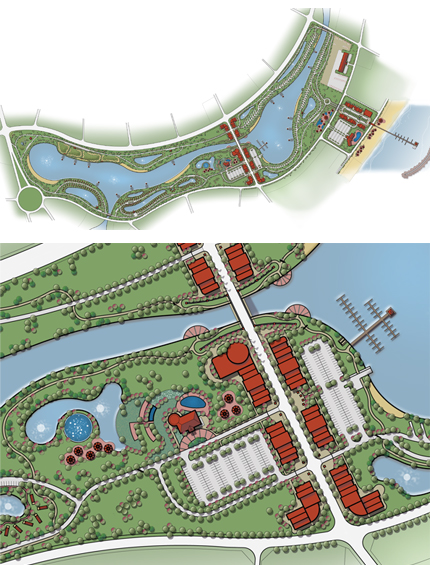
Outdoor Design Group, Inc. was founded in 2004 by Denver landscape architect Matt Corrion. The firm’s office is located in Olde Town Arvada, Colorado. Additional details about the Tangshan Bay Resort project will be shared as they become available. For more information please contact Outdoor Design Group at 303-993-4811.
This is the official blog of Outdoor Design Group, Colorado Landscape Architects. For more information about our business and our services, click here.
Related Posts:
by Matt Corrion
Some interesting trends have emerged this year in landscape design. In this article I describe the 5 hottest trends we are seeing – Which of these ideas will you incorporate into your landscape?
Outdoor Stone Fireplaces
Outdoor fireplaces have been around for a long time, but in the last few years they have really gained in popularity. They can serve as a focal point in the design of a backyard landscape, while providing the functional warmth of a fire adjacent to an outdoor patio.
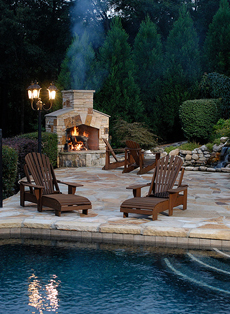 Here in Colorado, where the summers are dry and there are few mosquitoes or other insects, cool summer and fall evenings are perfect for gathering outdoors with family and friends. Outdoor stone fireplaces can add to the ambiance of your outdoor space.
Here in Colorado, where the summers are dry and there are few mosquitoes or other insects, cool summer and fall evenings are perfect for gathering outdoors with family and friends. Outdoor stone fireplaces can add to the ambiance of your outdoor space.
Design Considerations: Outdoor outdoor fireplaces are typically gas burning, unless the property is in a rural area with low fire danger where wood burning is allowed. They can either be custom built using a combination stone, masonry, brick, stucco, or stone veneer; or they can purchased as a prefabricated insert that is put in place and then faced with stone or another decorative material. A combination of decorative stone or concrete caps, mantels, and hearths can also be incorporated, resulting in an almost endless variety of design opportunities.
Due to the increased popularity of outdoor fireplaces and firepits, many municipalities are updating codes and ordinances to provide more specific restrictions and design guidelines. The required distance between the fireplace and any structure may vary between 15 to 25 feet. Always make sure your landscape architect or contractor has checked with your local building department on the current rules and regulations.
Pondless Water Features
Water is one of the building blocks of life. Water features can add a calming effect to your landscape through the sounds and movement of water. They can also mask unwanted noise and bring a peaceful calm to the hustle and bustle of urban living.
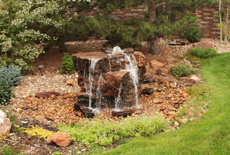 The problem with most water features is that they are high maintenance. While a natural looking pond can be beautiful, they are difficult to construct and can require quite a bit of maintenance. If that maintenance is neglected, or the pond is not constructed correctly one is left with pond that leaks, one does not look natural, or lacks the proper balance of plants, fish, and filters to keep the water clean.
The problem with most water features is that they are high maintenance. While a natural looking pond can be beautiful, they are difficult to construct and can require quite a bit of maintenance. If that maintenance is neglected, or the pond is not constructed correctly one is left with pond that leaks, one does not look natural, or lacks the proper balance of plants, fish, and filters to keep the water clean.
“Pondless” water features solve most of these issues, and are the hottest trend in water feature design. In a pondless water feature, and underground basin in purchased and installed below the ground to hold the water that is circulated through the feature.
A grate is often placed over the basin, and covered with rocks to allow the water to run through to the basin below. The water is pumped from the basin over a decorative rock or sculptural feature. The sound of water is achieved not only from the above ground feature, but by the water splashing through the rocks and into the basin below. And because the basin below ground is shaded from the sunlight, algae will not grow in the water.
Design Considerations: Depending on the size of the feature and how often you intend to run it, you may opt to install a filter and an auto-fill valve connected to a water supply to keep the feature full. You may also opt for an on/off switch for the feature at the home so you can easily turn it on or off. Don’t forget to plan for lighting the feature at night. And finally, when selecting a pump always error on the side of a larger pump, because the flow of water can always be dialed back but can never be increased.
Natural Lawns
As water prices continue to rise, homeowners and businesses are looking for alternatives to the traditional bluegrass lawn. As I have written about in the past, there are many advantages to making your landscaping more efficient, and reducing the amount of bluegrass lawn is the best way to do that.
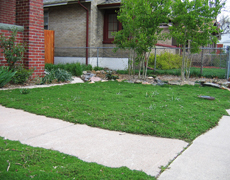 There are many types of plantings that can be used to replace a traditional lawn, but in each case the general principles are the same: plants with reduced watering requirements that require less maintenance. This can we achieved with alternative turfgrasses, Xeriscape plantings, edible garden plants, monocultures of spreading shrubs or perennials, native plants, non-natives, natural meadows, or a combination of these elements.
There are many types of plantings that can be used to replace a traditional lawn, but in each case the general principles are the same: plants with reduced watering requirements that require less maintenance. This can we achieved with alternative turfgrasses, Xeriscape plantings, edible garden plants, monocultures of spreading shrubs or perennials, native plants, non-natives, natural meadows, or a combination of these elements.
Another driver in the popularity of the “natural lawn” concept is the desire of individuals and organizations to move away from using pesticides, herbicides, and fertilizers in large quantities- for the benefit of the environment and human health. Children often play on lawns and in our parks. So in addition to replacing traditional lawns, some people are turning to more organic and natural methods of lawn care.
Design Considerations: It is important to realize that less maintenance does not necessarily mean easier maintenance (at least initially). What I mean by that is a more complex planting such as a Xeriscape with many types of plants, or a natural meadow, will take more analysis and careful monitoring than a simple lawn. However, this monitoring and analysis will be more than made up for by the savings in time and resources by avoiding all of that mowing, edging, aerating, fertilizing, etc. that a traditional lawn would require.
Covered Outdoor Patios
Covered outdoor patios work great for blending indoor and outdoor living space. Over the last decade outdoor patios and gardens have been increasingly utilized as an extension of indoor space.
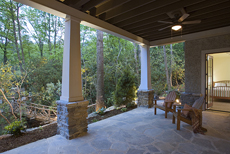 The latest trend is to build a waterproof roof structure over the top of an outdoor patio space. The roof structure is multi-functional, providing shade from the hot afternoon sun as well as protection from the rain and snow. Overhead roof structures also create a more intimate feeling space, creating an outdoor room at a much lower cost than adding a fully enclosed indoor room to a dwelling.
The latest trend is to build a waterproof roof structure over the top of an outdoor patio space. The roof structure is multi-functional, providing shade from the hot afternoon sun as well as protection from the rain and snow. Overhead roof structures also create a more intimate feeling space, creating an outdoor room at a much lower cost than adding a fully enclosed indoor room to a dwelling.
Another benefit to a covered outdoor patio is that outdoor amenities can be protected by the weather. Flat screen televisions, ceiling fans, outdoor kitchens, bar areas, speakers, and lighting can all be incorporated into this outdoor space.
Design Considerations: There are numerous design decisions that need to be made when designing a covered outdoor patio. Will the cover be attached to the home, or free-standing? Support columns for the roof structure can be designed with stone bases. The “ceiling” of the enclosure is also an important design element that should be carefully considered as it will probably be the main surface that you will see when using the space.
Urban Gardening
As the farming industry continues to get more commercialized and corporate, there has been a pushback in the form an increased demand for local farmers markets. And there is no place more local than one’s own yard.
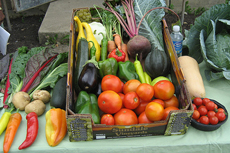 As individuals strive to have more control and knowledge of where their food comes from and how it is grown, many are turning to growing their own produce. Growing a garden is nothing new- however today’s gardens are getting larger and taking up a bigger percentage of the yard. In some cases, urban gardening is being used for an entire backyard or a good portion of a front yard.
As individuals strive to have more control and knowledge of where their food comes from and how it is grown, many are turning to growing their own produce. Growing a garden is nothing new- however today’s gardens are getting larger and taking up a bigger percentage of the yard. In some cases, urban gardening is being used for an entire backyard or a good portion of a front yard.
The urban gardening trend jives perfectly with the “natural lawn” trend. While some people are replacing their traditional lawn with decorative Xeriscapes, others are replacing their lawns with edible gardens. But even edible gardens can be beautiful- there are many decorative herbs that get showy flowers, and some produce such as bright red and yellow peppers can add visual interest to the landscape.
Design Considerations: If you are considering expanding or adding edible garden space there are a few aspects to be mindful of. If you have a homeowner’s association, remember to check their rules on gardens. Consider using decorative paths between your beds, and attractive raised planters can be utilized to keep the space looking a little more organized. Finally, be mindful of pests and rodents that may be attracted to the garden.
This is the official blog of Outdoor Design Group, Colorado Landscape Architects. For more information about our business and our services, click here.
Related Posts:
by Matt Corrion
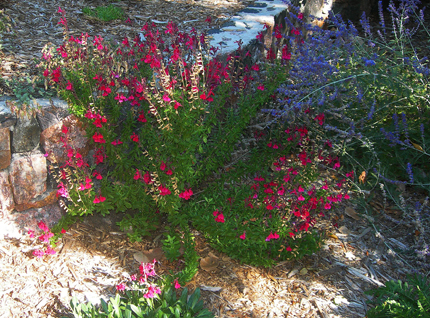
Furman’s Red Sage is wonderful small perennial that blurs the lines between perennial and shrub. It has a small, compact form and retains most of it’s leaves through the winter making it a more of a semi-evergreen shrub. And it’s magenta-red flowers just keep coming throughout summer and fall, making this plant a welcome addition to any dry landscape.
This plant combines well with many western natives, requiring little water and thriving in hot, sunny conditions. The unique bright colored flowers are a favorite of hummingbirds and gardeners alike.
PLANT STATS
Scientific Name: Salvia greggii ‘Furman’s Red’
Plant Type: Perennial or small semi-evergreen shrub
Mature Height: 24″-36″, stays pretty small and compact unlike many larger sages and mints
Mature Spread: 30″-42″
Cold Hardiness Zone: 5 – 9
Water Requirement: Low water needs. Seems to do equally well in dry conditions, or with supplemental irrigation. Follow a regular watering schedule the first growing season, but requires little water once established.
Exposure: Full Sun to light shade. Most of the literature on this plant says that it requires full sun, however I have experimented with it in partial shade and it also does well. In partial shade, flowering seems to start later in the summer/fall.
Flower Color & Bloom Time: Flowers are magenta to red, often exhibiting a unique bright magenta hue that sets this plant apart from other red flowering plants. Blooms appear in early to mid-summer and continue in fall through the first frost.
Winter Interest: Furman’s Red Sage grows into a small evergreen shrub that retains it’s leaves throughout winter, unlike most perennials.
Disadvantages: I have not found any to date. If given too much water or placed in too much shade, plants tend to get a little “leggy”, but since they stay relatively small they tend to still stay pretty compact and do not flop like excessively like larger perennials.
Availability and Sizes: This plant seems to be regularly available and has gotten quite popular. It is typically sold in 4-6″ pots, but may be found in 1 gallon containers as well.
Maintenance Tip: Cut back low to the ground in early spring to promote new growth. Leave evergreen stems and leaves up through the winter, some die-back may occur in cold winters.
Wildlife Value: Hummingbirds are attracted to the red flowers and regularly feed at this plant. Said to be deer resistant.
Best Features: Attractive magenta-red flowers that appear over a long period. This plant starts flowering in the middle of summer and continues flowering through late in the fall- one of the latest flowering plants here in Colorado.
Other: Also known as “Furman’s Red Texas Sage” or “Furman’s Red Autumn Sage”.
This is the official blog of Outdoor Design Group, Colorado Landscape Architects. For more information about our business and our services, click here.
Related Posts:



 The problem with most water features is that they are high maintenance. While a natural looking pond can be beautiful, they are difficult to construct and can require quite a bit of maintenance. If that maintenance is neglected, or the pond is not constructed correctly one is left with pond that leaks, one does not look natural, or lacks the proper balance of plants, fish, and filters to keep the water clean.
The problem with most water features is that they are high maintenance. While a natural looking pond can be beautiful, they are difficult to construct and can require quite a bit of maintenance. If that maintenance is neglected, or the pond is not constructed correctly one is left with pond that leaks, one does not look natural, or lacks the proper balance of plants, fish, and filters to keep the water clean.


